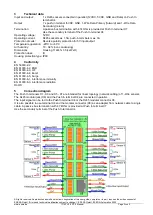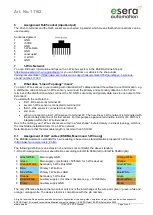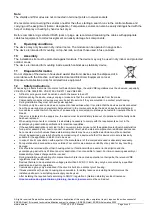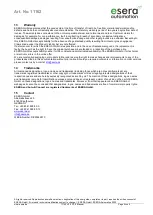
All rights reserved. Reproduction as well as electronic duplication of this user guide, complete or in part, requires the written consent of
ESERA GmbH. Errors and technical modification subject to change.
ESERA GmbH, ESERA-Automation 2020
www.esera.de
11162 V2.0 R1.0 Manual
Page 4 von 5
Note:
The shields and filler wires are not connected in terminal points or network sockets.
We recommend connecting the sensors one after the other, starting a search run via the control software and
carrying out the assignment (name / designation). Temperature sensors can also be easily distinguished with the
help of cold spray or heating by hand or hair dryer.
Before commissioning self-wired RJ45 jacks or plugs, we recommend measuring the cables with appropriate
cable test equipment. Incorrect assignment can easily damage bus components.
9
Operating conditions
The device may only be used in dry indoor rooms. The module can be operated in any position.
The device is intended for mounting on top-hat rails, such as those used in fuse cabinets.
10
Assembly
The installation site must be protected against moisture. The device may only be used in dry indoor and protected
outdoor areas.
The device is intended for mounting inside a switch cabinet as a stationary device.
11
Disposal information
Do not dispose of the device in household waste! Electronic devices must be disposed of in
accordance with the Directive on Waste Electrical and Electronic Equipment on local
Dispose of at collection points for old electronic equipment!
12
Safety instructions
When using products that come into contact with electrical voltage, the valid VDE regulations must be observed, especially
VDE 0100, VDE 0550/0551, VDE 0700, VDE 0711 and VDE 0860
All final or wiring work must be carried out with the power turned off.
Before opening the device, always unplug or make sure that the unit is disconnected from the mains.
Components, modules or devices may only be put into service if they are mounted in a contact proof housing.
During installation they must not have power applied.
Tools may only be used on devices, components or assemblies when it is certain that the devices are disconnected
from the power supply and electrical charges stored in the components inside the device have been discharged.
Live cables or wires to which the device or an assembly is connected, must always be tested for insulation faults or
breaks.
If an error is detected in the supply line, the device must be immediately taken out of operation until the faulty cable
has been replaced.
When using components or modules it is absolutely necessary to comply with the requirements set out in the
accompanying description specifications for electrical quantities.
If the available description is not clear to the non-commercial end-user what the applicable electrical characteristics
for a part or assembly are, how to connect an external circuit, which external components or additional devices can
be connected or which values these external components may have, a qualified electrician must be consulted.
It must be examined generally before the commissioning of a device, whether this device or module is basically
suitable for the application in which it is to be used.
In case of doubt, consultation with experts or the manufacturer of the components used is absolutely necessary.
For operational and connection errors outside of our control, we assume no liability of any kind for any resulting
damage.
Kits should be returned without their housing when not functional with an exact error description and the
accompanying instructions. Without an error description it is not possible to repair. For time-consuming assembly or
disassembly of cases charges will be invoiced.
During installation and handling of components which later have mains potential on their parts, the relevant VDE
regulations must be observed.
Devices that are to be operated at a voltage greater than 35 VDC / 12mA, may only be connected by a qualified
electrician and put into operation.
Commissioning may only be realized if the circuit is built into a contact proof housing.
If measurements with an open housing are unavoidable, for safety reasons an isolating transformer must be
installed upstream or a suitable power supply can be used.
After installing the required tests according to DGUV / regulation 3 (German statutory accident insurance
https://en.wikipedia.org/wiki/German_Statutory_Accident_Insurance)
must be carried out.























